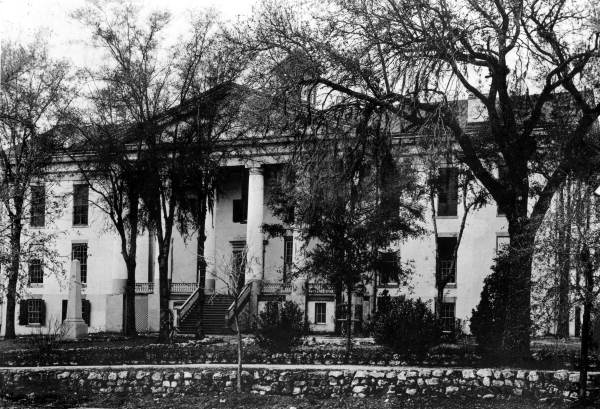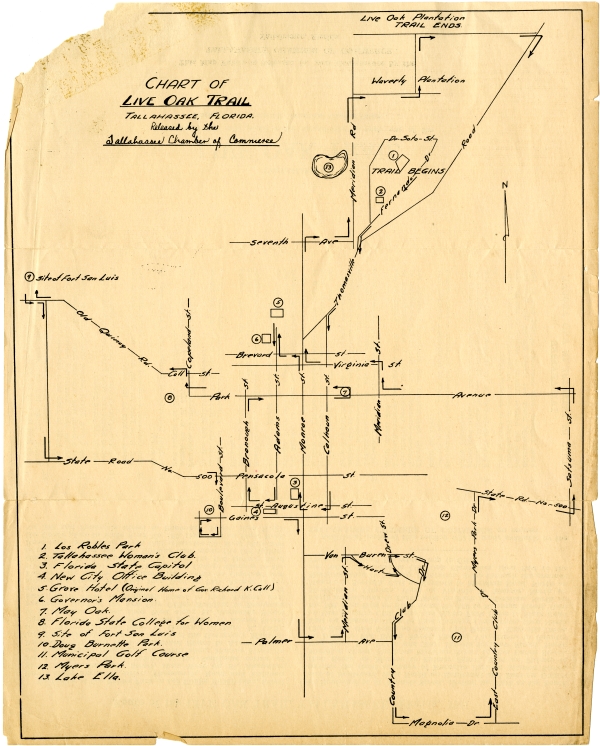Description of previous item
Description of next item
Tallahassee's Live Oak Trail
Published August 8, 2017 by Florida Memory
It’s hard to imagine Tallahassee without the beautiful live oak trees that line canopy roads and shade park-goers all over the city. As the city began to expand in the 1930s and cars became more ubiquitous, gas stations and storefronts popped up downtown and threatened the live oak trees. To expand the streets and keep the sidewalks clear of tree debris for pedestrian traffic, the trees had to be removed. Caroline Edwards Elliot thought differently, so she spent her life defending the capital city’s natural beauty.
Born in 1877 near Lloyd, Florida, roughly 25 miles from Tallahassee, Elliot was the oldest of seven girls. In 1900, she moved to Tallahassee and eventually worked as secretary to Governor Albert Gilchrist. After marrying Frederick Cotten Elliot in 1912, the couple built a new home at the corner of Gadsden and Virginia streets in Tallahassee. Frederick Elliot would soon become chief engineer of the Everglades drainage project. Caroline Elliot’s involvement with the Tallahassee Garden Club began in 1926 when the club was founded. She became an active member of the club by helping form the Oleander Circle in 1927, participating in committees, and later serving as president of the club near the end of World War II.

The people of Tallahassee have long valued the natural landscape of this area. In this photo, children gather for a May Day celebration under the May Oak at Lewis Park in Tallahassee in the early 1900s. Rubie Byrd was the May Queen. The tree was thought to be more than 100 years old when it collapsed in August 1986.
Over time, the Tallahassee Garden Club focused their attention on preserving the natural beauty of the city. One of the club’s first major initiatives was developing Lafayette Park into an arboretum during the 1930s. Though the onset of war halted this plan, Lafayette Park was for a period of time a vital part of the club’s activities. Together with botanists from Florida State College for Women (later Florida State University), Tallahassee Garden Club introduced native plant species to the park, many of which can still be seen today. The club also laid out paths so visitors could enjoy all of the plant and animal life that called Lafayette Park home.

Tallahassee Garden Club members in the early 1940s. Back, left to right: Almena Pierson, Caroline Elliot. Center: Gladys Henderson, Mary Dozier, Eva Thomas, Kate Bell. Front: Loranne Ausley, Reba Messer.
Elliot’s fight to preserve Tallahassee’s trees started at the end of 1938 when a developer planned to cut a 75-year-old live oak tree to make way for a service station near the Florida Capitol. Tallahassee Mayor J. R. Jinks approved the removal of the tree which was located downtown at the corner of Pensacola and Adams streets. A civic group composed of Elliot, the Tallahassee Garden Club, the Florida Federation of Garden Clubs, the Business and Professional Women’s Club and others protested the removal of the tree and demanded that the county commission revoke the permit. The protest received national attention and, as a result, the county commission voted in favor of the civic groups. In a statement that appeared in the Daily Democrat on December 15, Mrs. Covington, president of the Garden Club at the time, stated that “It just doesn’t seem right to take down a tree that is 75 years old to make room for a filling station that will be there only five or 10 years.”
This victory was just the beginning of Elliot’s campaign to save the trees, but not all of the efforts made by the preservation activists were successful. Many trees were removed downtown as new stores, streets and homes were built. In an effort to save as many trees as possible, Elliot initiated the annual Live Oak Trail with the purpose of drawing attention to the importance of preserving the city’s trees.

Entrance to the Los Robles neighborhood in Tallahassee (1930s). The Live Oak Trails of 1940 and 1941 both started at Los Robles Park.
The first trail was held on June 6, 1940, and led participants around the city to learn about and admire the majestic oak trees. Tallahassee residents opened their homes to the participants for luncheon parties and experts taught them about conservation. Notable Tallahassee residents such as Mary Call Collins, historic preservationist and wife of future Florida governor LeRoy Collins, and Ruby Diamond, generous benefactor to Florida State University and namesake of the auditorium on campus, were both in attendance.
More than 200 people attended the first trail and visitors from North Florida and South Georgia participated. Multiple organizations came together to make this event a success. The Chamber of Commerce and the Tallahassee Women’s Club assisted in arranging and executing the day’s events; and the Boy Scouts placed guiding markers and directed visitors during the trail.
The Daily Democrat published numerous stories about the trail, no doubt thanks to Elliot’s thoughtful planning. In her June 6 column, “Your Tallahassee and Mine,” Dorothy Van Brunt urged Tallahasseans to value their city’s trees: “It behooves Tallahassee as well as the state of Florida to become more tree-conscious. Other southern states have realized the value of trees to their well-being. Florida must eventually face the issue and follow suit.”
Then, the day after the trail, the newspaper ran a story with the headline “Live Oak Trail Proves Success.” This city-wide effort did exactly what Elliot had intended: the city’s oak trees were receiving the attention they deserved.

East front of the Capitol (now the Historic Capitol Museum) in 1900. In 1860, the city council of Tallahassee ordered that 200 trees be planted around the city, including around the Capitol building. This was the first effort by Tallahasseans to preserve the city’s natural beauty.
After the excitement of the first trail, Elliot didn’t waste any time planning the 1941 trail. She wrote to Senator Spessard Holland, the future governor of Florida, requesting that he mention Tallahassee’s beautiful trees in his inauguration speech. “It will mean much to us in our work of preserving the live oak trees on the streets and in the parks of Tallahassee,” she expressed to him.
With a whole year to plan the second trail, Elliot was able to exhaustively promote the event. To help guide participants during the event, the Chamber of Commerce published a map of the trail’s route that included a description of the order in which the trees should be viewed and places of interest around the city.
Over two days, April 13 and 14, hundreds of participants followed the 25 mile route by car around Tallahassee. Garden Club members served as guides along the trail and private residences and gardens were opened to the public. Not only was the trail promoting the live oak trees, but it also highlighted the many historic homes and buildings in the area, such as the Grove Park Hotel, the Governor’s Mansion, and the Capitol. Once again, the Daily Democrat reported on the trail with great enthusiasm and declared the trail as “one of the finest and most important developments in this community in recent years.”

Postcard of the Grove Park Hotel (later The Grove Museum) on N. Adams Street in Tallahassee (1930s). On April 13, 1941, the Daily Democrat wrote that “…the old mansion of Gov Richard Keith Call [Grove Park Hotel], which will be visited by participants in the Trail, is one of the noteworthy homes which should be preserved and made available as a point of interest to be visited by tourists and others.” After extensive restoration by the Florida Department of State, The Grove Museum opened to the public in 2017.
Despite two years of success, the Live Oak Trail was discontinued when the U.S. entered World War II in December 1941. The Tallahassee Garden Club spent their time contributing to the war effort by volunteering with the hospital, Red Cross, and Service Club. Elliot served as president of the garden club at the end of the war, from 1944 until 1946, during which time she attempted to revive the Live Oak Trail. Unfortunately, interest in the trail waned and it was permanently discontinued.
Postwar economic boom in Tallahassee led to further destruction of the city’s trees as the number of businesses downtown increased. In late October 1946, Tallahassee’s three city commissioners approved a plan to expand Tallahassee’s streets to accommodate the influx of car traffic downtown. Elliot and the community came together to oppose the expansion but with little success. Twenty-six trees were set to be removed along Calhoun Street with additional tree removal along College Avenue and Jefferson and Pensacola streets. Elliot and her husband quickly filed an injunction to stop tree destruction along these streets. Though the Elliots won the injunction in May 1947, many trees were cut down in the interim. But, without the hard work of the Elliots, the Tallahassee Garden Club, and all of the other tree activists during the 1930s and 40s, there would be fewer trees today in the capital city.
Selected sources:
Clements, Patricia Lasche. A Legacy of Leadership: Florida Governors and Their Inaugural Speeches. Tallahassee: Sentry Press, 2005.
“Live Oak Trail Proves Success.” Daily Democrat, June 7, 1940.
O’Bryan, Carolyde Phillips. The Live Oak Trail. Tallahassee: Sentry Press, 1999.
Tallahassee Garden Club, Inc. History Tallahassee Garden Club Inc. 1926-1960. Tallahassee, 1962.
Tallahassee Garden Club, Inc. Year Book of the Tallahassee Garden Club 1936-1937. Tallahassee, n.d.
“Tallahassee’s Live Oak Trail.” Daily Democrat, April 13, 1941.
“Tree Defense Fight Arouses Wide Interest.” Daily Democrat, December 15, 1938.
Van Brunt, Dorothy. “Your Tallahassee and Mine.” Daily Democrat, June 6, 1940.
Cite This Article
Chicago Manual of Style
(17th Edition)Florida Memory. "Tallahassee's Live Oak Trail." Floridiana, 2017. https://www.floridamemory.com/items/show/332811.
MLA
(9th Edition)Florida Memory. "Tallahassee's Live Oak Trail." Floridiana, 2017, https://www.floridamemory.com/items/show/332811. Accessed December 25, 2025.
APA
(7th Edition)Florida Memory. (2017, August 8). Tallahassee's Live Oak Trail. Floridiana. Retrieved from https://www.floridamemory.com/items/show/332811

 Listen: The Latin Program
Listen: The Latin Program
